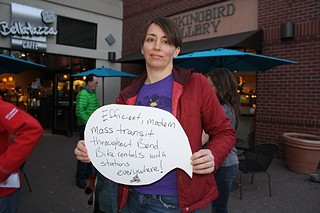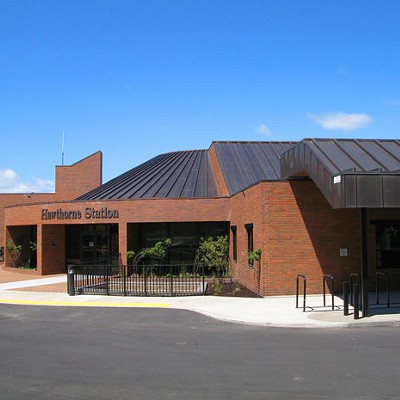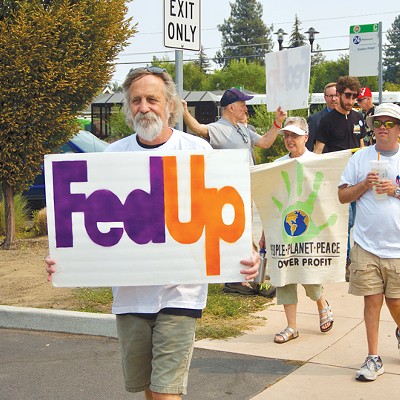When it comes to public transportation in Bend, the path toward progress has been fraught with political potholes. But Cascades East Transit has high hopes for smoother roads ahead.
Working in collaboration with the City, COCC, and OSU-Cascades, local business leaders, and community partners like Commute Options, Cascades East Transit (CET) is hoping to kick start community interest by securing an investment from some of the area's biggest employers.
"We did come up with a suite of improvements we think can meet an array of community needs. Now we're trying to figure out how to make those happen," explains Andrew Spreadborough, executive director of the Central Oregon Intergovernmental Council (COIC), which took over public transit from the City in 2010.
Among the improvements he hopes will roll out in the next six to eight months are extended hours, some new routes on the east and west side, and increased frequency—specifically, reducing wait times from 40 to 30 minutes.
And while COIC is still seeking permanent funding for public transit in Bend and the wider region, Spreadborough says he hopes that buy-in from employers, along with an increased investment from city and federal coffers, will be enough to unveil these initial improvements.
That buy-in is so far taking the form of employee and student group-pass programs. The idea is to get workplaces and schools to buy unlimited monthly passes for their employees and students at a steeply discounted rate, thereby increasing both revenue and ridership. And it's a screaming deal—the group passes cost just $2.50 per user per month. That's the same price as a single-use, full-price bus ticket.
Visit Bend and the Downtown Bend Business Association are already onboard, says Commute Options Executive Director Jeff Monson.
"We're reaching out to all the employers that Commute Options works with," he explains. "As more employers show up it's going to show the community this is an important part of our community."
Though the project is still in the early stages, partners are hopeful it will build the necessary momentum to sell the public on a long-term funding mechanism. Spreadborough says COIC is hoping the state legislature will allow it to put forward a property tax levy. But even with state approval, COIC will need to gather enough public support to pass a levy on the ballot. Recent surveys have shown that Bendites are not yet sold.
Last fall, COIC hired an outreach director to help sell the community on the value of a thriving public transit system—for riders and drivers alike.
"That's basically all that I'm working on," explains Judy Watts, who was hired as COIC's director of outreach and engagement last fall. "I have an outreach strategy that involves getting people more excited about transit."
As part of the larger effort to cultivate community buy-in for public transit funding, Bend 2030 hosted a transportation forum last weekend to brainstorm preferred improvements and funding methods.
About 175 people turned out for the event, says Bend 2030 Executive Director Erin Foote Marlowe. But, she points out, only one of these attendees took the bus to the forum. A handful came by bike, some carpooled, but the majority—including Marlow herself—arrived alone by car.
"It illustrated the lack of options, even for people who are really committed to the issues," Marlowe explains. "When you look at the [Bend 2030] vision, we can all agree we want this, but how do we accomplish it?"
One thing attendees seemed to agree on, she says, is that the entire community should shoulder the cost of improving and maintaining public transportation. As far as specific funding mechanisms, breakout groups shared a variety of ideas including a gas tax (for biking and pedestrian improvements), a transportation utility fee, and increasing enforcement of school speed zones to fund transportation infrastructure in the immediate area.
Bend 2030 will use the feedback from the forum to design a community survey on transportation over the next few weeks. The results from that survey will be distilled into a report that will allow the group to advocate for specific, community-supported solutions with local and state policy-makers.
During February, the most recent month for which data is available, Cascades East Transit gave about 32,000 rides on its fixed routes in Bend. COIC's Spreadborough says ridership is increasing, especially on its COCC route. Ultimately, though, the system needs to convert more so-called "choice riders"—those who have other transportation options, but might be inclined to choose the bus if it better served their needs.
"Build it and they will come," says City Councilor Victor Chudowsky. "People will use the system more if it is made more convenient, and that in turn will build public support. After a while, buses become part of the transportation landscape, and people expect the service and take it for granted, like in other cities."
And if the anticipated new routes and shorter wait times aren't incentive enough, Chudowsky points out that the buses now have WiFi connections, "so people have even more time to waste on Facebook."



























